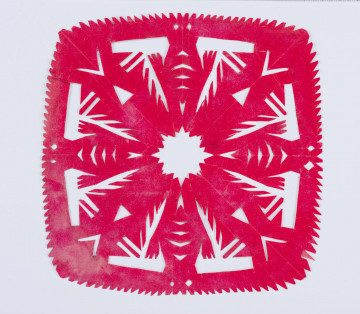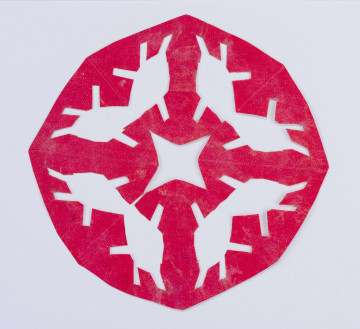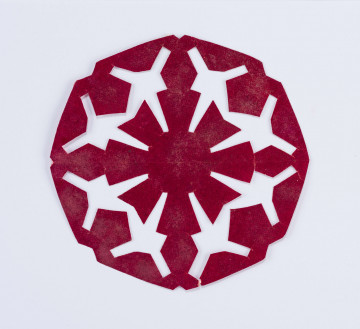
Cutout
1900 — 1920
National Museum in Lublin
Part of the collection: Folk Art of the Lublin Region (17th–1st half of the 20th c.)
Paper cutting is one of the most interesting, purely folk branches of fine arts. It is said to have originated in the first half of the 19th century and to have flourished in the second half of the 19th century. It was then that the decoration of home interiors developed in the Polish countryside - they were beautified before major church festivals, annual or family celebrations. Small paper forms were pasted on walls around paintings, over doors, beds, on ceiling beams, and were also used as decorations for carol singers' stars. They were usually cut out with sheep shears (see E/17672/ML). They were made from home-made coloured paper, later from bought paper - coloured glittering paper, shiny and smooth, available in several colours.
Cutting was done by women, occasionally by men, because this activity was not considered respectable. However, in the Lublin region, the most famous cut-out artist was Ignacy Dobrzyński (1882-1960) from the vicinity of Garbowo near Puławy, who, based on the traditional Lublin cut-out (see E/433/ML, E/457/ML), introducing new solutions, created his own style. The first works, presented in 1902 at exhibitions in Kraków and Warsaw, were sent to museums in Poland, America, Australia. Openwork circles, stars and stripes, characterized by a sense of composition, lightness and richness of motifs, became a model for others (see E/16193/ML, E/17674/ML).
In the interwar period and after the World War II the fashion for decoration of the country house changed - the desire to make it more like urban patterns caused resignation from own decorative creativity. The paper cut-outs from Lublin disappeared as a regional phenomenon, but they remained an expression of individual creativity. Interest in folk art aroused in urban environments, state protection, and activities of Cepelia cooperatives prevented the disappearance of paper cutting, which owes its name to artists and collectors. In the peasant culture circle the decorative paper forms were simply called costumes, cackles, jigs, paper decorations.
Author / creator
Dimensions
cały obiekt:
Object type
cutout
Technique
cutting
Material
Chalk paper
Creation time / dating
Creation / finding place
Owner
The National Museum in Lublin
Identification number
Location / status

1900 — 1920
National Museum in Lublin

1900 — 1920
National Museum in Lublin

1900 — 1920
National Museum in Lublin
DISCOVER this TOPIC
National Museum in Lublin
DISCOVER this PATH
Educational path